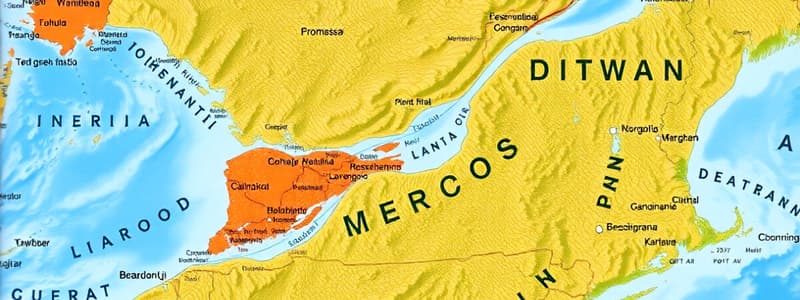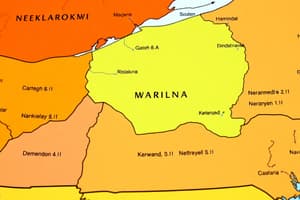Podcast
Questions and Answers
What is the Midwest commonly referred to due to its agricultural output?
What is the Midwest commonly referred to due to its agricultural output?
- The nation's breadbasket (correct)
- The nation's kitchen
- The nation's pasture
- The nation's grange
Which cultural contribution is strongly associated with New Orleans?
Which cultural contribution is strongly associated with New Orleans?
- Country western music
- Rock and roll
- Jazz (correct)
- Bluegrass
Which region is characterized by large cotton plantations and a history of slavery?
Which region is characterized by large cotton plantations and a history of slavery?
- The West
- The Northeast
- The Midwest
- The South (correct)
Which of the following best describes the general personality traits attributed to people in the Midwest?
Which of the following best describes the general personality traits attributed to people in the Midwest?
Which aspect of the South emphasizes a commitment to personal honor and valor?
Which aspect of the South emphasizes a commitment to personal honor and valor?
Which characteristic best describes the Northeast region of the United States?
Which characteristic best describes the Northeast region of the United States?
What was a notable aspect of New England's geographical features?
What was a notable aspect of New England's geographical features?
Which factor distinguishes the Middle Atlantic from New England?
Which factor distinguishes the Middle Atlantic from New England?
What misconception might one have about the boundaries between states and regions in the US?
What misconception might one have about the boundaries between states and regions in the US?
Which of the following states is NOT part of the New England sub-region?
Which of the following states is NOT part of the New England sub-region?
Which state is NOT part of the Navajo sub-region?
Which state is NOT part of the Navajo sub-region?
Which of the following statements is true about the Pacific Southwest?
Which of the following statements is true about the Pacific Southwest?
Which city serves as the headquarters for Mormonism in the Mormon sub-region?
Which city serves as the headquarters for Mormonism in the Mormon sub-region?
What significant event is associated with the year 1849 in the Pacific Southwest?
What significant event is associated with the year 1849 in the Pacific Southwest?
Which mountain in the Pacific Northwest is a known volcano?
Which mountain in the Pacific Northwest is a known volcano?
What is the nickname of Idaho, reflecting its mineral wealth?
What is the nickname of Idaho, reflecting its mineral wealth?
Which state is included in the Rocky Mountains sub-region?
Which state is included in the Rocky Mountains sub-region?
Which cultural influence is significant in the interior Southwest?
Which cultural influence is significant in the interior Southwest?
Flashcards
New England
New England
A region in the US containing the states of Maine, New Hampshire, Vermont, Massachusetts, Rhode Island, and Connecticut. Known for its historical significance, hilly terrain, and focus on shipbuilding, fishing, and trade.
The Middle Atlantic
The Middle Atlantic
A region in the US encompassing New York, New Jersey, Pennsylvania, Delaware, Maryland, and West Virginia. It features a diverse population due to early settlers like Dutch, Swedes, English Catholics, Quakers, Mennonites, and Amish.
The real Yankees
The real Yankees
A phrase used to describe people from New England, known for their shrewdness, thriftiness, hard work, inventiveness, and independent spirit.
Regional division
Regional division
Signup and view all the flashcards
State boundaries vs. regions
State boundaries vs. regions
Signup and view all the flashcards
The Midwest
The Midwest
Signup and view all the flashcards
What is the Midwest known for?
What is the Midwest known for?
Signup and view all the flashcards
What is the landscape like in the Midwest?
What is the landscape like in the Midwest?
Signup and view all the flashcards
The South
The South
Signup and view all the flashcards
What are the people of the South known for?
What are the people of the South known for?
Signup and view all the flashcards
The Navajo Sub-region
The Navajo Sub-region
Signup and view all the flashcards
The Mormon Sub-region
The Mormon Sub-region
Signup and view all the flashcards
The Pacific Southwest
The Pacific Southwest
Signup and view all the flashcards
The Pacific Northwest
The Pacific Northwest
Signup and view all the flashcards
The Rocky Mountains Subregion
The Rocky Mountains Subregion
Signup and view all the flashcards
Battle of Little Bighorn
Battle of Little Bighorn
Signup and view all the flashcards
Idaho: The Gem State & The Potato State
Idaho: The Gem State & The Potato State
Signup and view all the flashcards
The Southwest
The Southwest
Signup and view all the flashcards
Study Notes
American Cultural Regions
- Regions are more natural, but not officially defined, than state boundaries
- Four main regions: Northeast, South, Midwest, West
- Northeast includes New York City, New England, Mid-Atlantic states
- South stretches from Virginia to Texas (excluding Missouri)
- Midwest encompasses the area from Ohio to the Rocky Mountains, and from the Great Lakes to the Ohio River
- West encompasses the western portion of the United States excluding the Great Plains, plus Hawaii, and Alaska
The Northeast (Sub-region: New England)
- Smallest region, but historically important in American history including the beginnings of the American Revolution and abolitionism
- Primarily hilly terrain, not ideal for agriculture
- Strong history of shipbuilding, fishing, and trade
- Early settlers engaged in these professions and trades, which led to a thriving merchant marine during the mid-1800s
- Characterized by simple, wood-frame houses, white church steeples, and smaller towns
- Inhabitants were often described as shrewd, thrifty, hardworking, inventive, and independent; nicknamed "Yankees"
The Northeast (Sub-region: The Middle Atlantic)
- Includes New York, New Jersey, Pennsylvania, Delaware, Maryland (and West Virginia)
- Urban center of New York City
- Early settlers were primarily farmers and fur traders
- Diverse, with populations from Dutch, Swedish, English Catholic, Quaker, and Mennonite groups
- 19th century saw major industrial growth in iron, glass, and steel
- The area was significant for various early industry
The Midwest
- Extends from Ohio to the Rocky Mountains, and from the Great Lakes to the Ohio and Missouri rivers
- Called the "breadbasket" of America because of its large agricultural output, primarily wheat and corn
- Towns and farms utilize barbed-wire fencing to enclose livestock
- Known for a straightforward, down-to-earth, conservative, and helpful nature
- The Republican party formed in the 1850s to oppose the extension of slavery in this region
The South
- Strong historical consciousness owing to the Civil War defeat
- Two sub-regions: Lowland and Upland South
- Lowland South: large cotton plantations, with a large enslaved population
- Upland South: inland, poorer soil, with fewer slaves; difficult, harsh life
- Strong sense of hospitality, family values, and relaxed, unhurried lifestyle
- Distinct dialects, cultural inventions (such as blues, jazz, country music, country western), and a rich literary tradition
- Rich literary tradition, with many key figures such as William Faulkner and Flannery O'Connor
The West
- A very large, diverse region divided into sub-regions
- Sub-region: The Southwest
- Drier and emptier than the Midwest
- Strong Native American cultural impact; oldest cultures in the U.S.
- Harsh climates in various regions
- Historically colonized by Spain
- Sub-region: Pacific Southwest
- Population center in California, with large cities like Los Angeles
- Historically significant contributions from Spanish missionaries to agriculture
- Sub-region: Pacific Northwest
- Includes Washington, Oregon, and Northern portions of the Cascade and Rocky Mountains
- Urban centers are Seattle and Portland
Alaska
- Largest state, with a history of interaction between Native peoples and Russians trading for furs
- Historical importance connected with the gold rush of the late 1800s to early 1900s
- Tourist destination with natural beauty
Hawaii
- Volcanic islands, with a history of Polynesian migration
- Became an important center of trade/commerce/economics/ tourism from the mid-19th century to the present
- Diverse population, historically and presently
Studying That Suits You
Use AI to generate personalized quizzes and flashcards to suit your learning preferences.




